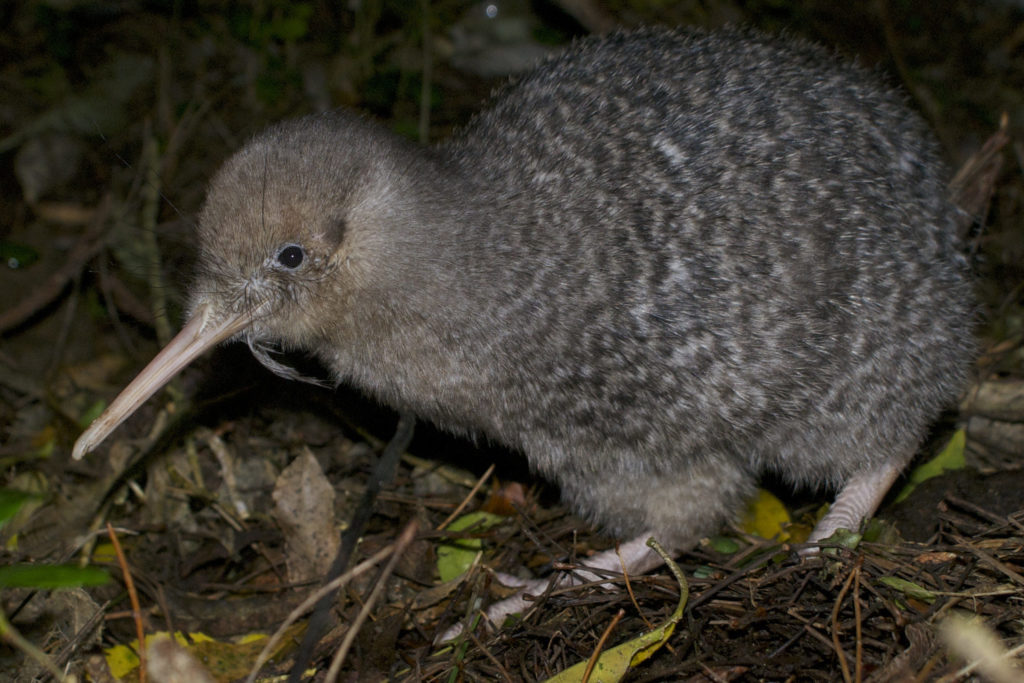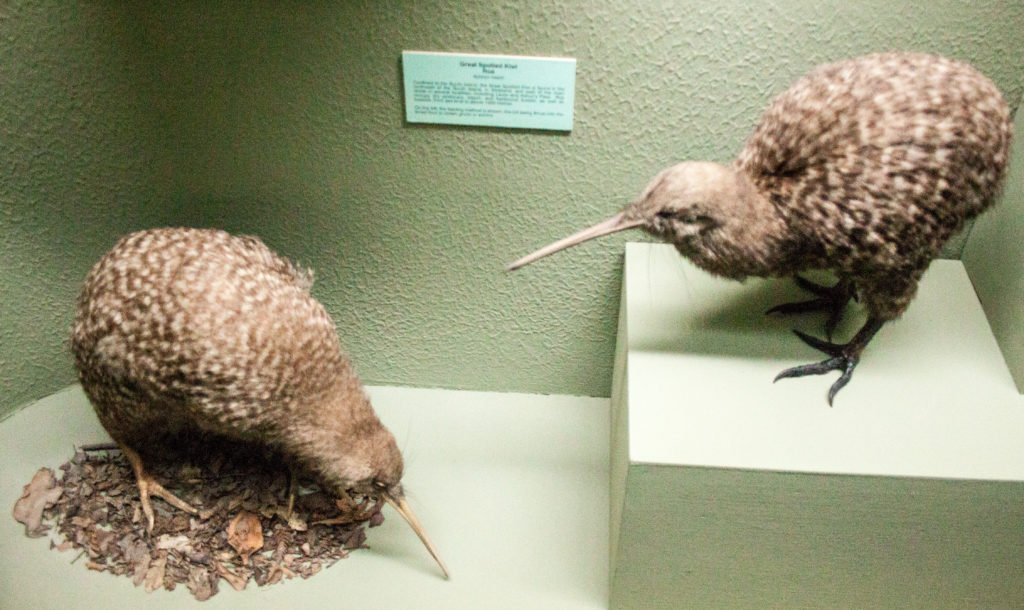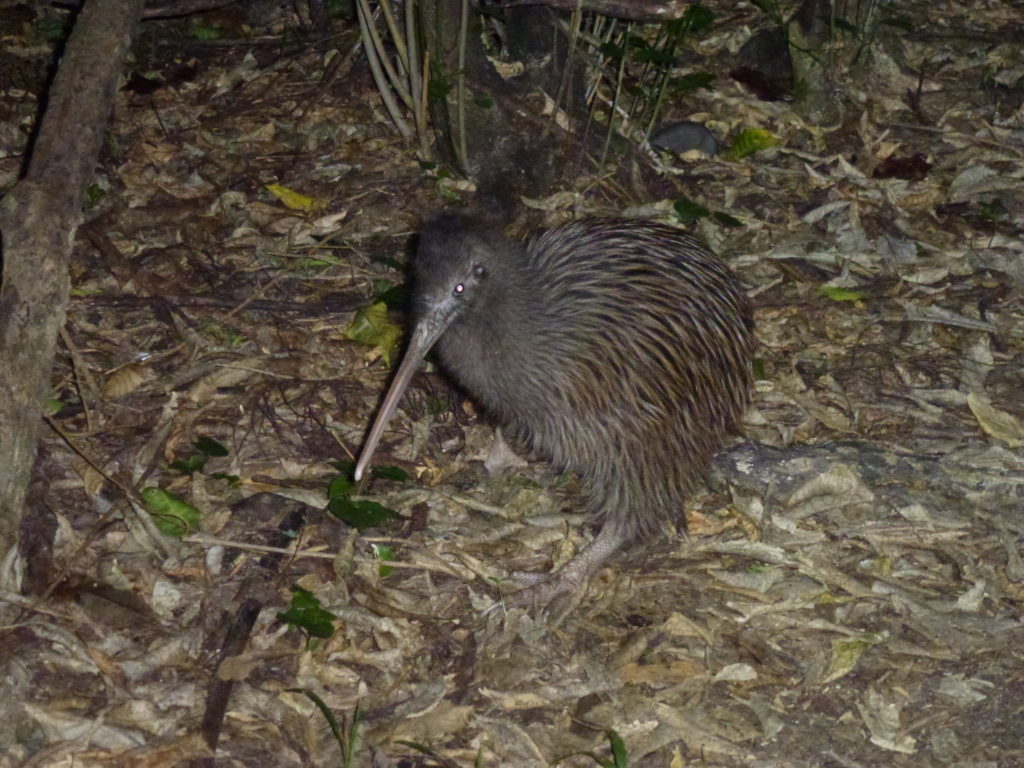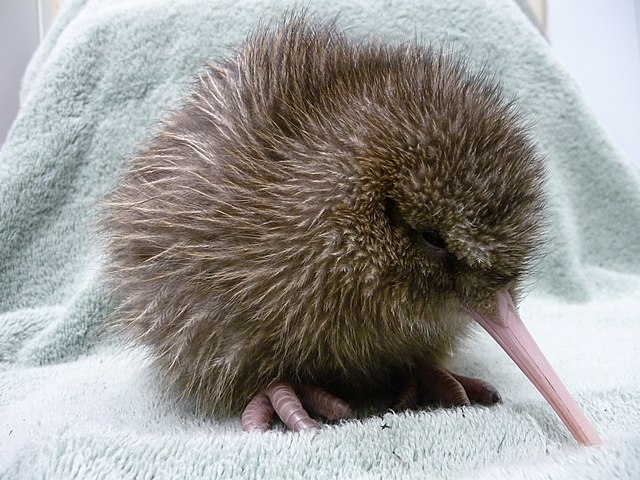Untangling the whakapapa of our kiwi can be more complicated than you might think – and appearances can sometimes be deceptive. It seems even the experts can get it wrong. All of which means that our Great Spotted Kiwi might be in for a name change.

In the case of Great Spotted Kiwi specimens collected in the 1870s, it seems the experts have been getting it wrong for almost 150 years. The mysterious museum exhibits might not be a Great Spotted Kiwi at all and that puzzle recently sparked a wider study of the genetics of kiwi past and present day.
The results revealed a few surprises. It wasn’t just the ancient Canterbury Museum kiwi that had a mixed kiwi parentage. It seems some of our other kiwi species have been mixing it up a bit genetically as well, even into the present day.
The Canterbury Museum hybrids are ‘snyntypes’ – specimens used to actually define what a Great Spotted Kiwi looks like and that has consequences. Our actual Great Spotted Kiwi, as opposed to the GSK hybrid, might be in for a scientific name change.
The genetic study was carried out by Lara Shepherd, Alan Tennyson, Hugh Robertson, Rogan Colbourne and Kristina Ramstad and was recently published in the open access international journal ‘Avian Research’.
So what family secrets did they discover on the Apteryx family tree?
“Some of the kiwi species are known to hybridise but the extent of hybridization is unknown. We reviewed hybridisation in kiwi (Apteryx spp.) and present new genetic data examining the extent of hybridisation between Rowi (A. rowi) and Little Spotted Kiwi (A. owenii) at Okarito, the location of the only remaining natural population of the threatened Rowi. We also genetically examined the syntype specimens of A. haastii, collected from near Okarito in the 1870s, which have unusual morphologies.”
Hybridisation between species is fairly common in nature, with birds showing particularly high levels of hybridisation. More than 16% of bird species are known to occasionally hybridise with at least one other species in nature, and this number increases to 21% when hybridisation in captivity is also included. Human-induced disturbances can greatly increase rates of hybridisation when habitats are modified or fragmented and organisms are introduced outside their natural range.
So why does hybridisation within our kiwi species matter?
“Hybridisation is a natural part of the evolutionary process and can have positive and negative outcomes. It can lead to increased genetic diversity, provide a source of adaptive genetic variation or even result in the formation of a new species. However, hybridisation can also lead to the merging of distinct evolutionary lineages and the genomic extinction of populations or species.”
Five species of kiwi are currently recognised, and they are estimated to have diverged from one another within the last 4-13 million years.
“These species fall into two morphological groups: brown coloured kiwi, comprising North Island Brown Kiwi (A. mantelli), Rowi (A. rowi) and Tokoeka (A. australis); and spotted kiwi, which have barred feathers, comprising Little Spotted Kiwi (Apteryx owenii) and Great Spotted Kiwi (A. haastii).
But what exactly does A. haastii – as defined by those museum specimens – refer to? The museum kiwi just didn’t look right when compared to modern-day Great Spotted Kiwi.

“There is uncertainty over what the name A. haastii refers to because the two syntype specimens of A. haastii (Canterbury Museum (CM) AV2828 and AV2829), which were collected inland from Okarito in 1870‒1871, have unusual morphologies with shorter and finer legs than Great Spotted Kiwi. This feature, combined with their collection locations, which are outside the known range of Great Spotted Kiwi and in the vicinity of where recent Little Spotted Kiwi × Rowi hybrids have been found, hints that they may have hybrid ancestry.”
Various kiwi species used to have much wider distributions than they have currently.
“Prior to human arrival, kiwi were found across New Zealand. Little Spotted Kiwi were found in both the North and South Islands but Great Spotted Kiwi were restricted to the northwest of the South Island. Brown kiwi were distributed across New Zealand with North Island Brown Kiwi located in the central and northern North Island, Rowi in the southern North Island and central west to northwest South Island, and Tokoeka in the southern and eastern South Island and Stewart Island. Therefore, Little Spotted Kiwi previously overlapped in distribution with the other four kiwi species. Great Spotted Kiwi and Rowi were also previously sympatric. However, the distributions of the three brown kiwi species apparently had no overlap.”
Since human arrival, kiwi numbers and distribution have declined, mainly because of predation by introduced mammals. There is currently no natural overlap between any of the species.
“Interspecific kiwi hybrids are known from the wild and a translocated population. In the wild most of the suspected hybrids have been found recently in the vicinity of Okarito and are thought to be hybrids between Little Spotted Kiwi and Rowi. These two species are no longer sympatric, with Little Spotted Kiwi last recorded from the South Island in 1978. Kiwi are long-lived for birds, e.g. the mean life expectancy of adult Little Spotted Kiwi is 45 years (95% CI 27–83 years), thus theoretically early generation hybrids could still be alive at Okarito, despite Little Spotted Kiwi no longer occurring there.”
Translocation of brown kiwi to Kapiti Island also allowed hybridisation to occur.
“The translocated population of brown kiwi on Kapiti Island has been shown through allozyme analysis to have a hybrid origin, with both Tokoeka and North Island Brown Kiwi ancestry. Both of these species, as well as Little Spotted Kiwi, were introduced to Kapiti Island in the early twentieth century. A number of mixed provenance kiwi populations (intraspecific hybrids) have been formed through translocations of genetically distinct lineages within North Island Brown Kiwi (e.g. Ponui Island and Little Barrier Island). Although these lineages are all currently considered to be North Island Brown Kiwi, future taxonomic changes are possible given the level of distinctiveness detected between them. Mixed provenance North Island Brown Kiwi also occur in captivity, although such populations are being phased out.”
There are benefits and threats to kiwi species from this mixing of the genetic pool.
“Hybridisation is a potential threat to kiwi diversity because it could result in the genomic extinction of small populations. For example, the entire natural distribution of Rowi, whose threat status is vulnerable, is restricted to a single population at Okarito. At the same time, hybrids may harbour genetic variation that is no longer found within current populations, particularly in Little Spotted Kiwi, which suffer from inbreeding depression and extremely low genetic variation owing to a species-wide bottleneck of at most five individuals. The conservation value of such hybrids is controversial—is it better to create a hybrid population that is genetically more diverse than the extant bottlenecked populations or retain genetically depauperate purebred populations?”

In this study, the researchers examine hybridisation between Little Spotted Kiwi and Rowi and investigate the Canterbury Museum mystery birds.
“Our objectives are to (1) determine the extent of past and present introgression between wild populations of Rowi and Little Spotted Kiwi at Okarito; and (2) investigate whether the syntype specimens of A. haastii Potts, 1872 are hybrids and discuss the taxonomic implications of our findings.”
But first, a brief introduction to some of the kiwi taking part in the study. Feather samples were used to determine the genetics of living kiwi.
“AllportsM is a male kiwi first caught near Franz Josef township in 1992 and moved to Mana Island in 1992. He was initially thought to be a Great Spotted Kiwi when first discovered based on the presence of barred feathers, which are characteristic of spotted but not brown kiwi. However, subsequent allozyme analyses and mtDNA sequencing suggested that he was a hybrid between a female Rowi and a male Little Spotted Kiwi. In 2006, AllportsM was moved to Allports Island in Queen Charlotte Sound.”
“Jess is a female kiwi found at Okarito in 2005 and subsequently also moved to Allports Island. Based on morphology (barred feathers), Jess was considered to be a hybrid between a Rowi and Little Spotted Kiwi.”
“AllportsM and Jess produced two known chicks, of which one, AllportsChick, was sampled.”
“An Okarito bird, BC0102_3, was thought to be the offspring of Jess and a Rowi male, produced before Jess was moved to Allports Island. If confirmed, this would make BC0102_3 a first generation Rowi backcross.”
Feathers were plucked for DNA analyses from AllportsM, Jess, AllportsChick and BC0102_3.
“NMNZ OR.30701 is a kiwi from Okarito whose feathers were sampled on several occasions in the wild between 1945 and 1947 and sent to Robert Falla who was Director of the Canterbury Museum at the time. Labels by Falla include information such as “Okarito Kiwi Cross” and “Feathers of the Okarito kiwi (australis? × haasti?)”. We analyzed the base of one of these feathers.”
“Three kiwi museum skins were sampled by removing a sliver of approximately 3 mm2 of footpad tissue from the underside of a toe with a clean razor blade. These were the two syntype specimens of A. haastii (CM AV2828 and CM AV2829), both of which are thought to be females based on their long bills and the neotype specimen of A. maxima, which was collected near Charleston in 1981 and determined to be female by dissection. Apteryx maxima is currently considered to be an invalid name (nomen oblitum) for Great Spotted Kiwi.”
In order to determine whether genetic material had been transferred between Little Spotted Kiwi and Rowi at Okarito, samples from 300 Rowi and 10 Little Spotted Kiwi were also analysed.
“The Rowi sampling represented 70% of individuals of the entire species at the time that these samples were collected.”
“We found evidence of recurrent hybridisation between Rowi and Little Spotted Kiwi over the last 150 years, including one F1 hybrid found in the last 15 years, despite Little Spotted Kiwi’s likely extinction on the mainland in the 1970s. However, we found little evidence of introgression of Little Spotted Kiwi alleles into the extant Rowi population. The syntype specimens of A. haastii were also found to be hybrids between Little Spotted Kiwi and Rowi.”
Not only were AllportsM and Jess shown to be hybrids – they might even have had the same parents.
“Combined, our morphological, mtDNA and microsatellite analyses suggest that hybridisation between Rowi and Little Spotted Kiwi, two species that may have diverged up to 13 Mya, has been occurring in the vicinity of Okarito for at least the last 150 years, with the most recent hybrid, Jess, found in 2005. The Allports Island birds AllportsM and Jess are F1 Rowi × Little Spotted Kiwi hybrids and each has a Rowi as their mother. It is even possible that they share the same parents because their mtDNA sequences are identical. These recent hybrids provide support for the survival of pure-bred Little Spotted Kiwi into the 1950s (or later) on the west coast of the South Island. The timing of the extinction of Little Spotted Kiwi in the South Island was poorly documented and has been the subject of considerable debate.”
AllportsChick was confirmed as their offspring, but that’s hardly surprising given there weren’t any other kiwi on the island. It does show, however, that first generation Rowi × Little Spotted Kiwi hybrids are able to successfully reproduce. Back at Okarito, however, BC0102_3 was found not to be an earlier offspring of Jess.
“Although our analyses show that BC0102_3 is not the offspring of Jess, they do suggest that this bird may have a more distant hybrid origin (a third or later generation Rowi backcross).”
The two mysterious museum specimen hybrids were found to have mitochondrial (maternal) DNA from Little Spotted Kiwi (CM AV2828) and Rowi (CM AV2829).

“We suggest that the decline of kiwi in the South Island contributed to the level of hybridisation that we document here. Hybridisation tends to be more common in areas where one species is rare, resulting in restricted mate choice. It has been suggested that in such situations it tends to be the females of the rarer species that choose heterospecific mates. We found evidence that both sexes of Little Spotted Kiwi were parents of hybrid offspring, although Rowi was the maternal parent for most of the hybrids we examined. Our results indicate that hybridisation in kiwi is not limited by body size differences.”
“We found more kiwi hybrids with Rowi, which are larger than Little Spotted Kiwi, as the maternal parent. However, kiwi exhibit reverse sexual dimorphism (with females larger than males) and therefore females are used to selecting smaller mates.”
The genetic integrity of the last remaining Rowi population at Okariti does not seem to have been compromised significantly by hybridisation, however.
“Despite our finding of recurrent hybridisation between Rowi and Little Spotted Kiwi around Okarito over the last 150 years, our microsatellite data, combined with our hybrid data simulations, suggest that there are no known F1 Little Spotted Kiwi × Rowi hybrids, or first or second Rowi backcross hybrids, currently within the Rowi population at Okarito.”
Because the syntype museum specimens of A. haastii are hybrids and therefore not representative of the prevailing usage of the name for the Great Spotted Kiwi (A. haastii), the researchers recommend resurrecting the disused name, A. maxima for the large spotted kiwi species.
“Our genetic analyses demonstrate that Potts’ (1872) description of A. haastii was based on two hybrid individuals and therefore this name does not represent what is commonly known today as the ‘Great Spotted Kiwi’. The next available name for the ‘Great Spotted Kiwi’ is A. maxima Sclater and Hochstetter, 1861, which was declared a nomen oblitum [disused name] by Palma et al. (2003) under Article 23.9 (the Reversal of precedence) of the International Code of Zoological Nomenclature in order to conserve nomenclatural stability. Our genetic data from the type specimen of A. maxima (NMNZ OR.22663) confirms that it is (1) not a hybrid, and (2) representative of the species today known as the ‘Great Spotted Kiwi’. Therefore, we resurrect the name Apteryx maxima for the ‘Great Spotted Kiwi’ under Article 23.3.5.”
The full research article is published in ‘Avian Research’ and freely available online.

